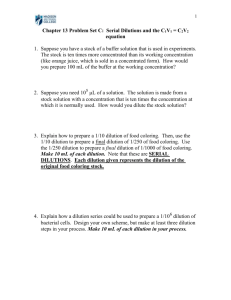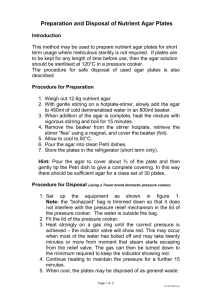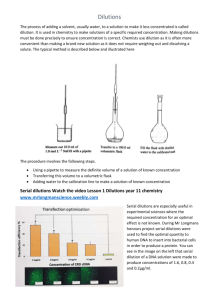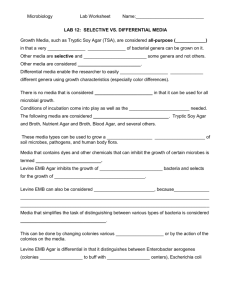Classical
advertisement
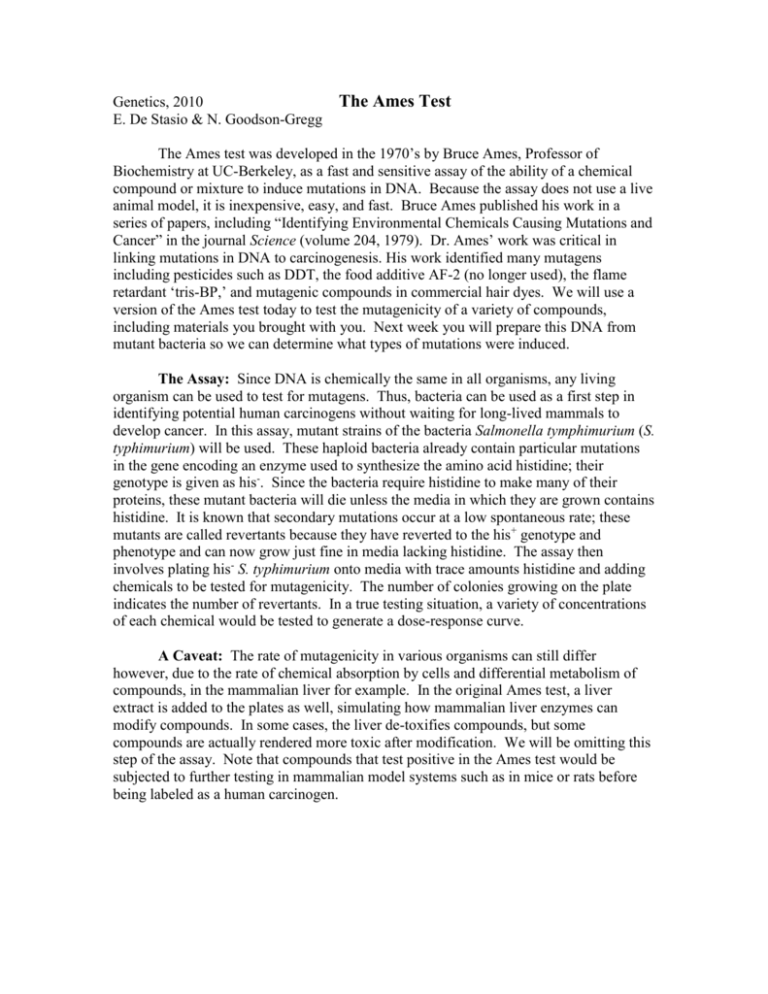
Genetics, 2010 E. De Stasio & N. Goodson-Gregg The Ames Test The Ames test was developed in the 1970’s by Bruce Ames, Professor of Biochemistry at UC-Berkeley, as a fast and sensitive assay of the ability of a chemical compound or mixture to induce mutations in DNA. Because the assay does not use a live animal model, it is inexpensive, easy, and fast. Bruce Ames published his work in a series of papers, including “Identifying Environmental Chemicals Causing Mutations and Cancer” in the journal Science (volume 204, 1979). Dr. Ames’ work was critical in linking mutations in DNA to carcinogenesis. His work identified many mutagens including pesticides such as DDT, the food additive AF-2 (no longer used), the flame retardant ‘tris-BP,’ and mutagenic compounds in commercial hair dyes. We will use a version of the Ames test today to test the mutagenicity of a variety of compounds, including materials you brought with you. Next week you will prepare this DNA from mutant bacteria so we can determine what types of mutations were induced. The Assay: Since DNA is chemically the same in all organisms, any living organism can be used to test for mutagens. Thus, bacteria can be used as a first step in identifying potential human carcinogens without waiting for long-lived mammals to develop cancer. In this assay, mutant strains of the bacteria Salmonella tymphimurium (S. typhimurium) will be used. These haploid bacteria already contain particular mutations in the gene encoding an enzyme used to synthesize the amino acid histidine; their genotype is given as his-. Since the bacteria require histidine to make many of their proteins, these mutant bacteria will die unless the media in which they are grown contains histidine. It is known that secondary mutations occur at a low spontaneous rate; these mutants are called revertants because they have reverted to the his+ genotype and phenotype and can now grow just fine in media lacking histidine. The assay then involves plating his- S. typhimurium onto media with trace amounts histidine and adding chemicals to be tested for mutagenicity. The number of colonies growing on the plate indicates the number of revertants. In a true testing situation, a variety of concentrations of each chemical would be tested to generate a dose-response curve. A Caveat: The rate of mutagenicity in various organisms can still differ however, due to the rate of chemical absorption by cells and differential metabolism of compounds, in the mammalian liver for example. In the original Ames test, a liver extract is added to the plates as well, simulating how mammalian liver enzymes can modify compounds. In some cases, the liver de-toxifies compounds, but some compounds are actually rendered more toxic after modification. We will be omitting this step of the assay. Note that compounds that test positive in the Ames test would be subjected to further testing in mammalian model systems such as in mice or rats before being labeled as a human carcinogen. Today’s experiment is in two parts: the exposure of S..typhimurium strains to potential mutagens (The Ames Test itself) and measurement of the number of bacteria in the cultures used to allow you to quantitatively assess the mutagenicity of the chemicals tested. Bacterial Strains: We will use two his- S. typhimurium strains in our screen for mutagens. TA1535 contains a T to C missense mutation in the hisG gene, leading to a leucine to proline amino acid substitution. TA1538 has a deletion of 1 base pair (C) in the hisD gene, which causes a -1 frameshift mutation. This changes two amino acids and brings a stop codon into the reading frame133 amino acids prematurely. Because there are different his- mutations in these strains, reversion to the his+ phenotype will require different molecular lesions (mutations). Since different mutagens can exert their effect on DNA through different mechanisms, using strains containing different mutations allows us to identify mutagens that have differing effects on DNA. Using your knowledge of gene structure and translation, you should try to predict what kinds of mutations could lead to reversion in each case. You should know that there are additional mutations in the bacterial strains used in the Ames test. Both of the strains have a defect in the lipopolysaccharide cell wall causing them to be more vulnerable to exogenous mutagens. Additionally, both strains have defective DNA excision-repair mechanisms. These mechanisms would normally correct mutations arising during DNA replication or from exogenous mutagens. A Word about Safety: During this exercise you will be handling strains of S. typhimurium and known or suspected mutagens. S. typhimurium is a pathogenic organism responsible for certain types of food poisoning, so be sure to follow proper microbiological technique. The mutagens we have chosen for this lab are not very harmful to humans and they are provided in low concentrations. Nonetheless, this is a good time to practice lab safety. Wear gloves when working with the bacteria or mutagens and keep these materials localized in one place on your bench. Known mutagens will only be applied to your plates in one place in the lab. Your instructor will be happy to do this application for you, if you do not wish to do so. Dispose of all gloves/plates/pipette tips in the biohazard containers (not the normal trash). Wash your hands before and after this week’s lab. Part I: Determining the Number of Bacteria in Overnight Cultures To quantitatively determine the mutagenicity of a compound, one must not only determine the number of mutant bacteria produced, but also the total number of cells exposed to the mutagen to begin with. This is particularly important if one wishes to 2 compare experiments done on different days or with different bacterial cultures. For example, say a new drug undergoing clinical trials causes allergic reactions in 20 patients. Before we make an assessment of the potential allergic properties of this drug, we need to know how many patients were exposed to the drug: were there 200 or 20,000 patients exposed? You will do your Ames test with a bacterial culture that was grown overnight. That is, the population of bacteria had been doubling by binary fission for about 10 hours. How many living cells are in that culture, say, per mL? How can we figure this out? We could use a spectrophotometer to determine the cell number per mL, as each cell scatters light when it is in solution. However, overnight cultures are ‘saturated,’ that is, they are at or near the carrying capacity of the nutrient broth in which they are growing, so some cells are dying but will still scatter light. It would be better to directly measure the number of living cells per mL. Each living cell is capable of dividing to produce 2 cells and so on – on a solid surface these aggregate cells will form a colony. We will thus measure colony-forming units (CFU’s) in a culture. Overnight cultures of bacteria like S. typhimurium exhibit variation in CFU concentration, typically containing 2x108–2x109 CFU’s/mL. The human eye obviously cannot distinguish such a large number of individual colonies, so we will determine the number of CFU’s in a given culture by spreading serial dilutions of the overnight cultures on nutrient-rich agar plates and counting the resulting colonies after about 20 hours of growth at 37oC. The steps involved in calculating CFU concentration are not difficult, but they do require exacting precision when using the pipetters. Think about how a small error at one of the first few dilutions could affect all the subsequent dilutions. How much would a pipetting error of 0.1 mL be magnified after six or seven serial dilutions? With this in mind, take your time and be sure to conduct this experiment with care. Your data will reflect your pipetting skills and plating consistency. You will want to count 100 or fewer colonies on your plates. You will be plating 100 µl of your dilutions – remember that 1000 µl = 1 mL or, 100µl = 0.1 mL. If you expect your overnight culture to contain 2x108–2x109 CFU’s/mL, how many 1 in 10 or 1:1 serial dilutions should you do? Plan to plate 2 dilutions, one of which is 50% less concentrated than the other. Recall that a 1 in 10 dilution means adding 1 volume of a liquid to 9 volumes of a liquid (as in 1 mL culture + 9 mLs water or 100 µl culture + 900 µl water). Serial dilutions means diluting a stock solution, then diluting the dilution that you just made even further, then diluting that dilution….(see Figure 1). Determine how many serial dilutions you need to make and what the dilution factor is (Figure 1). Lastly, determine how you can make one last dilution that is only half the concentration of the previous dilution. Plan to plate the contents of the last 2 dilutions. Before actually creating the dilutions, check your protocol with the instructor or lab assistant to be sure you have an appropriate plan. 3 Figure 1: An example of serial dilution. The relative concentration of each dilution (or dilution factor) is shown beneath each tube. When you count the number of colonies on your plate, you can simply multiply the colony number by the dilution factor to determine how many CFUs were in the 100 µl that you plated. Then multiply by 10 to determine the CFUs/mL of the overnight culture. Will a 106 concentration be dilute enough for your experiment? Creating and Plating Serial Dilutions: 1. Determine the number of serial dilutions that you will perform, and what the final dilution factor of each of your dilutions will be. Write all of these concentrations on labeling tape and apply to the microcentrifuge tubes (include the strain name and your initials). Make sure you label all the intermediate dilutions, as it is easy to lose track of which one you are on. 2. Apply Bacdown to your work area and allow it to dry. Your instructor or lab assistant will demonstrate proper microbiological technique and pipetter use at this time. 3. Gently vortex your overnight solution to mix up the sediment at the bottom of the test tube (approximately 5-10 seconds). 4. Pipet approximately 900 µl of your overnight culture into your first empty microcentrifuge tube. Vortex thoroughly for approximately 5 seconds. 4 5. Pipet 900 µl of the sterile water into every microcentrifuge tube except the ones containing the original overnight culture solution and the final dilution. 6. Pipet 100 µl of your full strength overnight solution into your first serial dilution microcentrifuge tube (should contain 900 µl of sterile water). Vortex thoroughly. 7. Repeat this process for all of your serial dilutions. 8. Label your Petri dishes with the strain name, concentration, group initials, and date. Write in small letters around the edges of the bottom of the dish. The lids may get mixed up, but the Petri dish will always stay with the agar! 9. Pipet 100 µl of one of your serial dilutions onto the center of the L medium agar plate. Perform this step carefully, as the liquid tends to bead up and roll around the dish. The desired result is one large drop in the center of the dish. Don’t puncture the surface of the agar- this is a surface application. 10. Flame sterilize the hockey stick spreader, briefly touch it to the agar away from the bacteria, and then spread the bacteria over the surface of the agar. 11. Repeat steps 9-10 for one other serial dilution. Think about why having data from two different dilutions is important. 12. Allow the plates to sit for about 10 minutes, invert and put together with tape, then incubate for 24 hours at 37oC. 13. Count the resulting colonies and record your observations. 14. Using the estimated concentrations of your serial dilutions, determine the CFU/mL content of your original solution and express the standard error as a +/- value. Find the average of both the dilutions (you will have to adjust for the differences in concentration). Note that you only plated 0.1 mL of the dilutions, not a full mL. 5 Part II: Ames Test Experimental Design: Each group of two students will be given materials to prepare an experiment in which a total of 10 plates may be used. Each plate will eventually contain 1 strain of bacteria exposed to one concentration of one chemical, for example. You and your partner should design a carefully controlled experiment using both TA1535 and TA1538. Determine what will work best as positive and negative controls. Two chemicals with known mutagenicity are available to you. Sodium azide (NaN3) is a white solid that is highly soluble in water. Because it easily kills bacteria in high enough concentration, it is used as a preservative in some chemical solutions; its degradation via electric shock is used to inflate car airbags. 4-nitro-o-phenylenediame (4NOP) is an orange-red powder previously used in hair dyes. In the late 1970’s the National Cancer Institute (NCI) noticed that there was an abnormally high incidence of bladder cancer among workers in the dye industry, so they requested a bioassay of 4NOP to determine its mutagenic potential. 4NOP produced positive results in the Ames test and it is considered a potential mutagen. While choosing your mutagens, you should think about the nature of the organism you are testing. Although the strains of S. typhimurium used in the Ames test are his-, most bacteria are not. The incubation conditions used in this experiment are idea for many microorganisms, and many types of fungi and bacteria will readily grow on both top agar and Vogel-Bonner medium. You should be meticulous in your sterile procedure to ensure that no outside contaminants enter your Petri dishes. Furthermore, you should do your best to ensure that there are not microorganisms in the mutagens you are testing. For example, that nasty week-old casserole in your mini-fridge will probably produce many bacterial colonies if you test it as a potential mutagen. This does not necessarily mean your casserole is mutagenic. If you choose a potential mutagen that may have microorganisms in it (e.g. river water), talk to your instructor or lab assistant as soon as possible to see if it is autoclavable. If you suspect your potential mutagen may already have bacteria that can survive on a nutrient-deficient medium, think about how you could test this. Finally, remember that S. typhimurium is affected by anti-microbial substances. Determine what mutagens you will be testing, and discuss your concentrations and application procedure with your professor. Ensure that your plates are labeled to reflect the mutagens you will test and their concentrations. Put your potential mutagens into solution at the concentration you discussed with your professor or lab assistant. Typically most mutagens will be suspended in 1 mL of water and placed in an microcentrifuge tubes 6 Ames Test Basic Procedures: 1. Label each plate with strain name, mutagen+concentration, group initials, and date. 2. Apply Bacdown to the laboratory bench where you will be performing bacterial transfers. Allow the surface to dry. Do not place bacteria near the surfaces that are still wet with Bacdown. Inoculating Top Agar with S. typhimurium: IMPORTANT NOTE: When working with top agar it is essential that you complete all your transfers quickly. Top agar will begin to set up once you remove it from the hot water bath, so all the following steps should be completed in approximately one minute. So, read through the directions first and figure out who is doing what. Do a “dry run” where you practice each movement as a team first. 3. Briefly vortex the overnight culture of S. typhimurium you wish to test. A small pellet of cells often forms at the bottom of test tubes containing overnight bacterial cultures; the goal is a uniform distribution of all cells in the media. 4. Wearing gloves, flame the lip of the overnight culture and remove 100µL of the overnight culture solution. Flame the lip of the test tube before you put the cap back on. It is often difficult to pipet out of a test tube without contaminating the pipetter itself. If you do touch the edge of the test tube, briefly wipe down the pipetter with Bacdown before using a new bacterial strain to prevent cross-contamination. 5. Remove one tube of top agar from the hot water bath, remove the plastic cap, briefly flame the lip of the tube, and slowly add the 100µL of overnight culture solution. Flame the lip again and replace the cap. Do not forcibly pipette the overnight culture solution into the top agar, as this will introduce bubbles into the agar. Ultimately, these bubbles will be transferred to your agar plate and will make the process of colony counting much more difficult. 5. Briefly (3-5 seconds) vortex the test tube of top agar and bacteria. 6. Gently pour the top agar onto a labeled minimal glucose agar plate. Again, avoid producing bubbles. Once the agar sets, small bubbles will look almost identical to bacterial colonies. 7. With the lid of the Petri dish on, gently distribute the top agar over the surface of the plate. A rocking figure eight motion typically works best. The top agar will start to harden in 15-20 seconds, so be quick. 8. Wait ten minutes before moving any plates with top agar on them. 7 Exposing S. typhimurium to Different Mutagens: While allowing the top agar to harden completely, you may prepare your potential mutagens for use. Several potential mutagens will be supplied for you and you will have brought some of your own as well. Solid substances can be blended with sterile water as aqueous substances will diffuse in the agar and contact the maximum number of bacteria. Waxy materials might be easily melted in the microwave and then applied to filters. We find that placing mutagen solutions on sterile filter paper disks produces consistent results. If your mutagen is difficult to put into solution, direct application is a viable option. The following steps are for application of a mutagen in solution: 9. Flame sterilize your forceps after dipping them in 95% ethanol and allow the forceps to cool for a few seconds. 10. Using the lid of the glass Petri dish as a protective cover, remove one sterile filter paper disk with your forceps. 11. Ensure that the cover for your microcentrifuge tube is secured and lightly flick the tube to evenly distribute your mutagen in the solution. This is especially important with 4NOP because it is highly insoluble in water. Repeat this step every time you use a mutagen. 12. Pipette 10 µL of the test solution directly onto the center of the filter paper. 13. Using the lid of the Petri dish as a protective cover, place the filter paper (mutagenside down) onto the top agar. 14. Repeat this process for each plate. 15. Tape your plates together, label them with the date and your group initials, invert the plates (to prevent condensation) and incubate for approximately 48 hours at 37oC Counting the Revertant Colonies on Your Plates: 1. Remove nutrient-rich plates (CFU concentration experiment) after 18-24 hours of incubation. 2. Make notes on colony characteristics such as size, shape, and color. 8 3. Count each colony on your plates. Make sure to be consistent in your definition of a colony. All colonies come from one revertant bacterium, so all colonies should be counted the same, regardless of size. If there are an excessive number of revertant colonies on a plate (over fourhundred), you may want to count only ¼ of the plate and then multiply your final result by four. This is known as the quadrant counting method, and it is less accurate than counting all the colonies on a given plate. 4. Remove nutrient-deficient plates (Ames test) after about 48 hours. 5. Repeat steps 2+3 for these plates. 6. Calculate reversion frequency as # of revertant colonies per mL/total # of CFU’s per mL of appropriate overnight culture. 7. Select one plate which contains revertant colonies you wish to test for molecular lesions. Label one of the provided large test tubes (this should contain approximately 5mL of L. medium) with the same information that is on your selected plate. Place your plate in the 4oC refrigerator and replace the test tube in the appropriate area. Your lab assistant will prepare one colony from your selected plate in an overnight culture solution before the next laboratory period. 9 Ames Test Week I: Materials Needed in Lab Materials for each group (groups of 2): 10 mL overnight L medium broth culture of each of the following strains: TA1538, TA1535 12- L medium plates (L. medium+1.5% bacto agar)- 12 plates per lab group 10 Vogel-Bonner medium E plates 11 tubes of 3 mL bio-his top agar, liquified (autoclaved) in hot water bath (57oC) 1 test tube rack (for large test tubes) 1 test tube containing 5ml of sterile L. medium 1 p1000 1 p200 1 p20 1 pipetman rack 1 box p200 tips 1 box p1000 tips (can probably share between groups- only need 20 or so) 1 pipette tip bucket 1 Bunsen burner 1 bottle Bacdown 1 Miracloth 1 jar 95% ethanol 1 Plating hockey stick 1 vortex mixer 1 bottle sterile ddH20 Labeling Tape Materials for Lab: 1 mL of sodium azide @ 0.05 mg/mL 1 mL of 4-nitro-o-phenylenediamine @ 0.5 mg/mL 3 large hot water baths (set to 57oC) 1 Box each size glove 1 biohazard trash bag 3 bottles of sterile H20 3 sterile forceps 2-3 Petri dishes of sterilized filter paper disks 1 jar 95% ethanol 3 blenders 5 microfuge racks 1 beaker sterile microfuge tubes 1 square bottle sterile H20 1 area of Benchkote for very hazardous chemicals 2 beakers of sterile 1.5 ml microcentrifuge tubes 10


